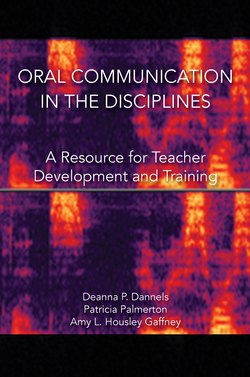Читать книгу Oral Communication in the Disciplines - Deanna P. Dannells - Страница 7
На сайте Литреса книга снята с продажи.
ОглавлениеAcknowledgments
We are grateful to the many people who have contributed to this text and our scholarship throughout the years. David Blakesley’s support of this project has been vital as we brought the text to fruition. We are also grateful to Jared Jameson for copyediting the manuscript. Thanks also go to the students who assisted us with sources and citations at various points in the project: Hannah Jaffe (North Carolina State University), Raven Timmons (University of Kentucky), and Aubrey Fonfara (Hamline University).
We extend our thanks to colleagues who provided reviews of the manuscript: Susan McLeod (University of California, Santa Barbara), Sean Connin (Trinity University), Jon P. Rust (North Carolina State University), Krysta Kirsch (Ohio State University), Wendy Atkins-Sayre (University of Southern Mississippi), Ann Darling (University of Utah), and April Kedrowicz (North Carolina State University). Thank you to the faculty who granted permission for us to use rubrics and assignment descriptions: Diane Clayton (Hamline University), Jon D. H. Gaffney (Eastern Kentucky University), and George Vane (Hamline University).
Deanna Dannels would like to acknowledge several people who have influenced the project in important ways. Co-authors Patricia Palmerton and Amy Housley Gaffney have been collaborative and engaged partners; their commitment to the project and the process of writing made the time working together fulfilling and productive. Deanna is also grateful for Ann Darling who provided her with the initial opportunity (twenty years ago) to learn in the trenches about what it means to do communication across the curriculum. Working with the engineers during that time changed the path of her work and forever sculpted the way she thinks about and tinkers with teaching and learning. She would also like to acknowledge Chris Anson, who has been a partner in communication across the curriculum for many years; her faculty development commitments and practices cannot be unraveled from what she has learned from her collaborations with Chris. Finally, she would like to thank Karl Lehmann and Emma Grace Lehmann; this project took attention and time and they were there, throughout, always with loving smiles and hugs.
Patricia Palmerton would like to acknowledge the pioneers of Speaking Across the Curriculum, Robert O. Weiss of DePauw University, and Charles Roberts of East Tennessee State University who provided support and insight to her in the early stages of her work on communication across disciplines. She is also grateful for the help and support of Hamline University faculty, in particular Alice Moorhead, for her pedagogical insights, and James Francisco Bonilla and Colleen Bell for many long discussions about diversity in the classroom. Finally, she is indebted to her good friend and mentor, Robert L. Scott, for his insights into rhetoric as epistemic, which has influenced her thinking about the implications of communication pedagogy.
Amy Housley Gaffney would like to thank Deanna Dannels and Chris Anson for providing strong role models of what cross-curricular work should entail. She extends thanks to the students and faculty who have been open to exploring new ways to understand competent communication in teaching, learning, and research. She also thanks Jon D. H. Gaffney (Eastern Kentucky University) for continued discussions about curriculum, pedagogy, and life in general.
Finally, the administrators, faculty, and students we have worked with over the years from many disciplines have made this project possible. In your struggles and triumphs, you have brought to life the work in this book; propelling us to continuously share our passion for communication across the disciplines. You deserve our utmost thanks.
Section I: Oral Communication—Why and How?
In our experience, faculty members have mixed feelings when it comes to teaching students about oral communication. On the one hand, you might believe it is a good idea to provide your students with experience in discipline-specific communication activities. Yet, you might also think the teaching of speech would feel like an add-on to the content-focused work you do in your courses and, hence, is less central to your mission. You might truly want to help students learn to be better communicators, but you might also have limited ideas about how to do so. In this introductory section, we discuss these issues, provide a rationale for including oral communication instruction in your classes, and attempt to address some of the more common concerns that faculty members like you express when integrating oral communication activities and practices into the classroom.
